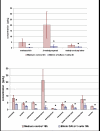Release of volatile organic compounds (VOCs) from the lung cancer cell line CALU-1 in vitro
- PMID: 19025629
- PMCID: PMC2639533
- DOI: 10.1186/1475-2867-8-17
Release of volatile organic compounds (VOCs) from the lung cancer cell line CALU-1 in vitro
Abstract
Background: The aim of this work was to confirm the existence of volatile organic compounds (VOCs) specifically released or consumed by lung cancer cells.
Methods: 50 million cells of the human non-small cell lung cancer (NSCLC) cell line CALU-1 were incubated in a sealed fermenter for 4 h or over night (18 hours). Then air samples from the headspace of the culture vessel were collected and preconcentrated by adsorption on solid sorbents with subsequent thermodesorption and analysis by means of gas chromatography mass spectrometry (GC-MS). Identification of altogether 60 compounds in GCMS measurement was done not only by spectral library match, but also by determination of retention times established with calibration mixtures of the respective pure compounds.
Results: The results showed a significant increase in the concentrations of 2,3,3-trimethylpentane, 2,3,5-trimethylhexane, 2,4-dimethylheptane and 4-methyloctane in the headspace of CALU-1 cell culture as compared to medium controls after 18 h. Decreased concentrations after 18 h of incubation were found for acetaldehyde, 3-methylbutanal, butyl acetate, acetonitrile, acrolein, methacrolein, 2-methylpropanal, 2-butanone, 2-methoxy-2-methylpropane, 2-ethoxy-2-methylpropane, and hexanal.
Conclusion: Our findings demonstrate that certain volatile compounds can be cancer-cell derived and thus indicative of the presence of a tumor, whereas other compounds are not released but seem to be consumed by CALU-1 cells.
Figures




References
-
- Amann A, Smith D, (eds) Breath Analysis for Clinical Diagnosis and Therapeutic Monitoring. Singapore: World Scientific; 2005.
-
- Amann A, Spanel P, Smith D. Breath analysis: the approach towards clinical applications. Mini Rev Med Chem. 2007;7:115–129. - PubMed
-
- Schubert J, Miekisch W, Nöldge-Schomburg G. VOC breath markers in critically ill patients: potentials and limitations. In: Amann A, Smith D, editor. Breath Analysis for Clinical Diagnosis and Therapeutic Monitoring. Singapore: World Scientific; 2005. pp. 267–292.
-
- Risby T. Current status of clinical breath analysis. In: Amann A, Smith D, editor. Breath Analysis for Clinical Diagnosis and Therapeutic Monitoring. Singapore: World Scientific; 2005. pp. 251–265.
-
- Schubert JK, Miekisch W, Geiger K, Noldge-Schomburg GF. Breath analysis in critically ill patients: potential and limitations. Expert Rev Mol Diagn. 2004;4:619–629. - PubMed
LinkOut - more resources
Full Text Sources
Other Literature Sources
Medical
Miscellaneous

